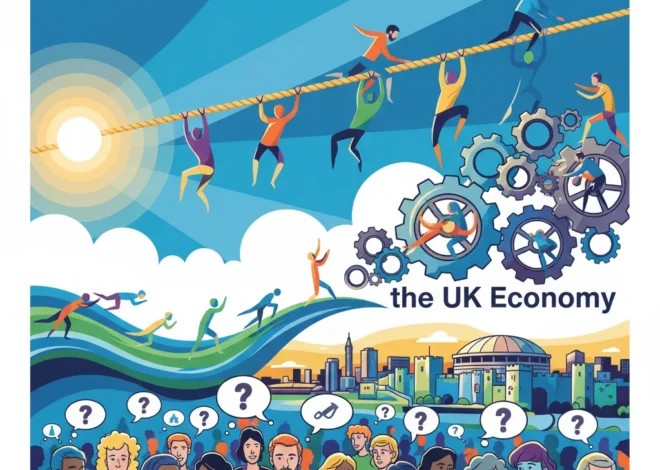
Beyond the Payslip: A Deep Dive into the UK’s Trillion-Pound Fiscal Engine
Every month, a portion of your earnings vanishes before it ever reaches your bank account. It’s a universal experience for anyone on a payroll, a line item on a business ledger, and a percentage added at the checkout. We call it tax. But beyond the immediate sting to our personal finance, have you ever truly paused to consider the scale and destination of this colossal flow of capital? The UK government collects over a trillion pounds annually, a figure so vast it can be difficult to comprehend. This isn’t just an administrative exercise; it’s the financial bedrock of the entire nation, funding everything from motorways to medical care.
Understanding this fiscal machinery is no longer just for economists or policy wonks. For investors, business leaders, and anyone serious about their financial future, grasping the intricacies of public finance is crucial. The government’s decisions on taxation and expenditure create ripples that affect the entire economy, influencing everything from the stock market and investment opportunities to the stability of the banking sector and the future of financial technology. Let’s pull back the curtain on the UK’s tax system and follow the money to see where it goes and, more importantly, why it matters.
The Revenue Engine: Deconstructing the Trillion-Pound Income Stream
The government’s vast income isn’t drawn from a single source but is a composite of various taxes, each tapping into different aspects of the economy. While dozens of individual taxes exist, the heavy lifting is done by three primary pillars that form the bulk of the UK’s tax revenue.
According to analysis from the BBC, these “big three” are Income Tax, National Insurance Contributions (NICs), and Value Added Tax (VAT). Together, they represent the lion’s share of the government’s receipts. Understanding their individual roles is the first step in decoding the nation’s economic health.
- Income Tax: This is the most significant single source of revenue. It’s a progressive tax levied on personal earnings, including salaries, pensions, and some savings. The more you earn, the higher the rate you pay on the portion of your income that falls into higher bands.
- National Insurance Contributions (NICs): Often seen as a “second income tax,” NICs are paid by both employees and employers. Historically, they were intended to fund specific social security benefits, most notably the State Pension. While the funds now go into the same general pot, NICs remain a cornerstone of the UK’s revenue system.
- Value Added Tax (VAT): This is a consumption tax. Applied to the sale of most goods and services, the standard rate is 20%. It’s a less visible tax than the deductions on your payslip but is a powerful and stable revenue generator, intrinsically linked to the pulse of consumer spending in the economy.
While these three are the largest, other taxes such as Corporation Tax (on company profits), council tax, fuel duties, and business rates also make substantial contributions. Here is a simplified breakdown of the UK’s main tax revenue sources to put their contributions into perspective.
| Tax Category | Approximate Contribution to Total Revenue | Primary Source |
|---|---|---|
| Income Tax | ~25-30% | Individual Earnings, Pensions, Savings |
| National Insurance Contributions | ~20-25% | Employee and Employer Contributions |
| Value Added Tax (VAT) | ~15-20% | Consumer Spending on Goods & Services |
| Corporation Tax | ~5-10% | Company Profits |
| Other Taxes | ~15-20% | Fuel Duties, Council Tax, Business Rates, etc. |
Note: Percentages are approximate and can fluctuate based on economic conditions and policy changes.
This distribution reveals the delicate balance the government must strike. A heavy reliance on income-based taxes makes revenues sensitive to the health of the labour market, while a reliance on consumption taxes like VAT makes them vulnerable to shifts in consumer confidence and spending habits. For those involved in finance and economics, this balance is a key indicator of fiscal stability.
The Spending Puzzle: Where Does a Trillion Pounds Go?
Collecting the money is only half the story. The allocation of these funds is where policy meets reality, shaping society and directing the course of the economy. Government spending, known as public expenditure, is dominated by a few key areas that consume the vast majority of the budget.
The largest single area of expenditure is Social Protection. This broad category includes the State Pension, which accounts for a massive portion, as well as Universal Credit and various other welfare benefits. The UK’s aging population means the cost of the State Pension is on a structural upward trend, a critical factor for long-term economic planning. In a typical year, this can account for around a quarter of all public spending (source: OBR).
The second-largest recipient is Health. The budget for the National Health Service (NHS) is a colossal figure, covering everything from GP salaries and hospital infrastructure to cutting-edge medical research. This spending is often politically sensitive and subject to immense public scrutiny, making it a central pillar of any government’s fiscal agenda.
Following closely are Education, which funds schools, colleges, and universities, and Defence. However, one of the most interesting and often overlooked categories is Debt Interest. The UK, like most developed nations, carries a national debt. The interest payments on this debt are a legally binding, non-discretionary expense. When interest rates rise, this line item can swell dramatically, squeezing the available budget for all other public services. This direct link between monetary policy (interest rates) and fiscal policy (government spending) is a critical nexus for anyone involved in finance or investing.
Here’s a high-level overview of where your tax money is spent:
| Spending Area | Key Components | Economic Significance |
|---|---|---|
| Social Protection | State Pension, Universal Credit, Disability Benefits | Supports household income, consumption, and poverty reduction. |
| Health | NHS funding, Hospitals, GP services, Medical Research | A major employer and critical for a productive workforce. |
| Education | Schools, Higher Education, Skills Training | Drives long-term productivity and economic growth. |
| Debt Interest | Payments on government bonds (gilts) | Highly sensitive to interest rates and investor confidence. |
| Defence | Armed Forces, Military Equipment, Intelligence | National security and a significant industrial sector. |
Why This Matters for Investors, Businesses, and the Broader Economy
Understanding public finance is not an academic exercise; it has tangible consequences for your wealth, your business, and your investments.
For investors, government fiscal policy is a primary driver of market sentiment. High levels of government borrowing can lead to an oversupply of government bonds (gilts), potentially pushing up yields and making them more attractive relative to equities. This can impact the stock market. Furthermore, specific spending decisions create sectoral opportunities. A government commitment to green energy, infrastructure, or digital transformation can signal lucrative areas for investing. A tax cut for corporations can boost company profits and share prices, while a hike can have the opposite effect. The stability of a nation’s finances is a proxy for its overall economic stability, a key factor in any trading or investment thesis.
For business leaders, the tax and spend equation defines the operating environment. Corporation Tax rates directly impact profitability and decisions on where to invest. Government spending on infrastructure—like transport and broadband—can reduce business costs and improve productivity. The health of the education system determines the quality of the future workforce. Moreover, the overall level of taxation in the economy influences consumer disposable income, a critical variable for any B2C company. As the government explores new technologies, opportunities in areas like GovTech, a subset of fintech, are expanding rapidly.
For the broader economy, fiscal policy is one of the two major levers for management, the other being monetary policy from the central bank. Government spending is a major component of Gross Domestic Product (GDP). In a downturn, the government can increase spending (fiscal stimulus) to boost demand. The challenge, as we’ve seen globally, is the resulting increase in national debt, which must be serviced for decades to come. The long-term health of the economy depends on a sustainable fiscal path where tax revenues are sufficient to cover spending without excessive borrowing.
The UK's Inflation Paradox: Why Falling Rates Don't Mean Cheaper Groceries
The rise of new technologies presents both challenges and opportunities. There is growing discussion in economics circles about how blockchain could be used to create more transparent and efficient public spending, or how AI and advanced financial technology could revolutionize tax collection and compliance, reducing fraud and administrative costs. These innovations could be key to solving the fiscal challenges of the 21st century.
A Forward Look: Navigating Future Fiscal Challenges
The system of tax and spend is not static. It is constantly evolving to meet new challenges. The demographic shift towards an older population will continue to place immense pressure on pension and healthcare budgets. The transition to a net-zero economy will require vast public investment. And in an increasingly digital world, the very nature of how we tax—particularly multinational tech giants and decentralized finance—is a subject of intense international debate.
As these pressures mount, the demand for transparency and efficiency will only grow. Citizens and investors alike will need to remain vigilant, scrutinizing government finances and holding policymakers accountable. Understanding the data—where the money comes from and where it goes—is the first and most crucial step in that process. It empowers you to look past the headlines and understand the fundamental economic forces shaping our world, from the global stock market to the money in your own bank account.
In conclusion, the journey of a taxpayer’s pound is a complex one, flowing through a sophisticated system of collection and allocation that forms the lifeblood of the UK. It’s a system of trade-offs, priorities, and profound economic consequences. By understanding its mechanics, we move from being passive contributors to informed stakeholders, better equipped to navigate the financial landscape and make smarter decisions for our future.

